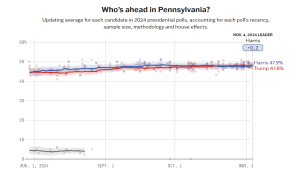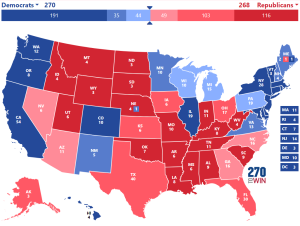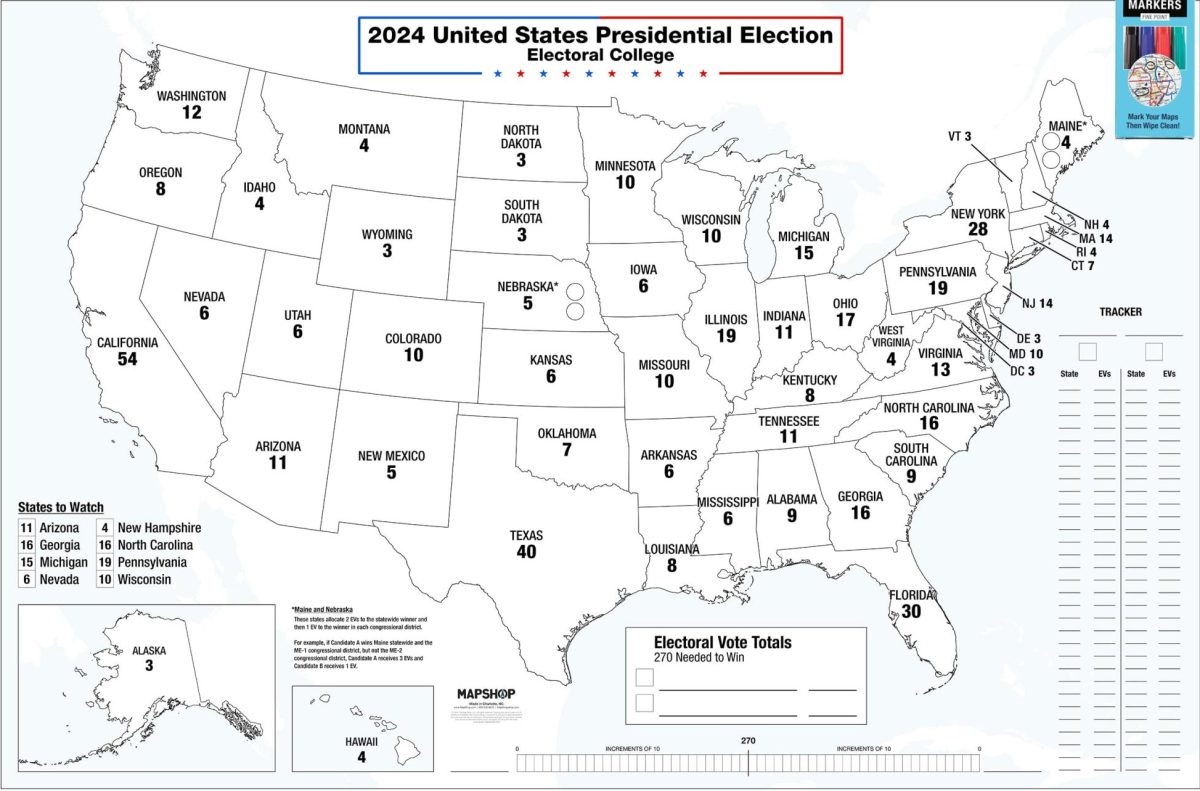Every single election year, the idea of a tie in the Electoral College is presented, and each time it is, I sigh and roll my eyes due to the stark improbability of that event. It seems as if the past few elections have been marked as some of the closest in history. Every four years, that title is given yet again. This year takes it to a whole new level.
This year, we are witnessing a unique situation where a tie in the electoral college is not only a theoretical possibility but a potential outcome.
Assuming all historically red and blue voting states remain the same in this election, excluding swing states, the electoral college votes are 226 for Vice President Kamala Harris and 230 for former president Donald Trump, putting him barely in the lead. In the past few weeks, I’ve been adamantly checking and refreshing the polls and predicted outcomes to attempt to grasp where we’re at in this election, and, quite frankly, it’s baffling how close every single poll is. In each swing state, the leads are marginal, typically less than one point.
Arizona
Of all of the swing states, Arizona currently holds the largest percent lead, with Trump preceding Harris by 2.2 points. However, in the 2020 election, President Joe Biden won the state by a slight 0.3 points, breaking the 24-year-long precedent of the red-voting state due to the rapidly changing condition of Phoenix. So, although Arizona has historically voted Republican, there is still a chance for a toss-up in this election, as Trump was winning in the majority of Arizona polling in the 2020 election (Politico). Although a majority of the state is conservative due to the vast rural land and repeated republican officials, the Latino and Indigenous populations spread throughout the state and concentrated in Phoenix may be enough to sway the vote toward Harris; for now, however, it is the most stable of the battleground states.
Wisconsin
Wisconsin is leaning blue by 1.1 points, a minimal lead with a large margin of error due to the inaccuracy of polling. Wisconsin was won by Biden in 2020 by only .63%, the closest it’s been since 2004. The last time Republicans won the state was in the 2016 election, a pivotal state for Trump’s support in the midwest and a major deciding factor in the election turnout and results. Excluding 2016, however, Wisconsin has voted blue in every 2000s election, so although Harris holds the majority, it’s still a toss-up, and it’s not currently possible to fully predict who the state will go for. The Great Lakes States, including Minnesota, Wisconsin, and Michigan, along with other parts of the midwest, have typically voted Democratic, with 2016 being an outlier for Wisconsin and Michigan (FiveThirtyEight).
Michigan
In recent years, Michigan has been one of the largest political battlegrounds in the presidential race largely due to the inconsistency and proximity in polling, with Trump making his final campaign stop in Grand Rapids just last night. Both parties have made a concerted effort across the state and, more specifically, in Detroit, which will be a deciding factor in Michigan’s decision, as Harris is currently leading by only 1 point. Michigan has been losing electoral votes in past years due to increased population loss in Detroit and its loss of production and thriving urban life. However, Michigan is still pivotal in the election process as Trump won the state in 2016 and Biden in 2020, making it an unpredictable vote (YouGov).
North Carolina
Trump narrowly leads North Carolina by only 0.9 points in recent polls, similar to how they’ve previously voted, as the state last voted blue in the 2008 election and has voted red by marginal amounts since. In the past few months, there has been more effort concentrated in North Carolina than ever before due to the rarity of the polls, with Trump winning by such slight amounts despite the state being historically Republican. Just this last weekend, Harris and Trump visited Charlotte in an attempt to win over the state in the closest toss-up yet (Forbes).
Georgia
Georgia is a rare state in the election that is based almost entirely around the stark contrasts between the rural, conservative areas of the state and the almost entirely blue Atlanta area and surrounding suburbs. These two opposing sides typically even out with voters on both sides, leading to a close election turnout in past elections. In 2016, they voted for Trump, and in 2020, they voted for Biden, but this year, Trump is winning by 0.7 points (270).
Nevada
Since the 2008 election, Nevada has voted blue; despite this, Trump is currently in the lead by 0.3 points. Las Vegas is a large democratic-leaning city in Nevada, but many of the rural Mormon populations make up a significant portion of conservative voters in the state. Mormons are one of the most right-leaning religious groups in the U.S., as their importance placed on traditional family values tends to fall in line with Republican ideals and pro-life policies. Still, Trump has been losing some support from Mormon voters due to decreasing support from the Mormon Church in Nevada, leading in part to Biden’s win in 2020 (Center of American Life).

Pennsylvania
Suppose all of the predicted poll results turn out as expected. In that case, Pennsylvania quickly becomes the most critical state in the election as predicted results would put Trump at 268 electoral college votes and Harris at 251 without it. However, currently, the state is leaning toward Harris by only 0.2 points. If Harris wins the state and the rest of the swing states vote as predicted, she would win over Trump by only two points, undoubtedly leading to numerous recounts and turmoil throughout the country. Pennsylvania polls have been coming back almost dead even, and it’s impossible to tell which way the state will lean as it’s so close. Pennsylvania voted red in 2016 and blue in 2020. Historically, it has gone back and forth while typically voting Democratic (Forbes).
Now, in the extremely unlikely case of a tie, the odds being placed at roughly 0.2%, the choice of president would go to the House, and the choice of vice president would go to the Senate, meaning that Trump would likely win (Forbes). There are a few different scenarios for what would lead to a tie; for example, if Harris wins “The Blue Wall” (Michigan, Wisconsin, and Pennsylvania) and Trump wins the other four swing states, not an entirely unlikely combination, it would result in a tie. Another more unlikely situation is if a state ended up voting for a third-party candidate that took away votes from either side. Still, there aren’t any largely prominent third-party candidates, and looking at it from a historical perspective, it’s incredibly unlikely it’ll happen.

Currently, if all swing state polls remain accurate, the 2024 election would result in a final result of 270 electoral votes for Harris and 268 for Trump, but the margins are so close that it’s difficult to tell who will pull ahead in time. Either way, this won’t be an easy open-and-shut election. It’s likely that the votes will be recounted multiple times, and there have already been claims from some Republicans that if Harris wins, the election was falsified, which begs the question of whether something worse than the Jan. 6 insurrection could occur if Harris wins.
This is one of the most historically significant elections of the century, and it’s so incredibly close that it’s almost impossible to predict a winner. Either way, this will be an election to be remembered.


























































































